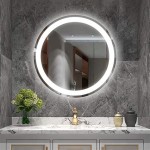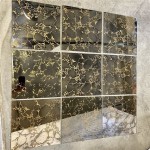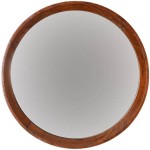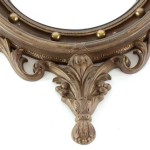Louis Philippe Mirrors: A Timeless Reflection of Elegance
Louis Philippe mirrors, characterized by their gently rounded upper corners and understated ornamentation, represent a distinct period in French design history. Emerging during the reign of King Louis Philippe I (1830-1848), these mirrors transitioned from the opulent styles of the preceding Empire era to a more restrained elegance. This period of French history, mirroring the socio-economic climate, favored practicality and comfort alongside a subtle display of wealth. Louis Philippe mirrors, therefore, embodied this shift, becoming a staple in bourgeois homes and grand chateaux alike.
The era of Louis Philippe was one of industrial advancement and a growing middle class. This had a direct impact on furniture production, including mirror manufacture. While handcrafted techniques persisted, the early stages of mass production allowed for a wider distribution of classically influenced, yet more accessible, designs. This accessibility contributed to the lasting popularity and enduring appeal of Louis Philippe mirrors, making them a sought-after antique and a favored accent in contemporary interiors.
The distinctive aesthetic of Louis Philippe mirrors differentiates them from other antique mirror styles. Understanding these features is crucial for identification, authentication, and appreciation of their historical significance. While variations exist, certain hallmarks consistently define the Louis Philippe mirror.
Key Features and Characteristics of Louis Philippe Mirrors
The defining characteristic of a Louis Philippe mirror is its gently curved or rounded top corners. This is a departure from the sharp angles of earlier styles. The curvature is subtle, almost imperceptible in some cases, contributing to the mirror's overall soft and elegant appearance. The bottom corners are typically squared off, providing a visual anchor and grounding the design. This combination of curved and straight lines creates a balanced and harmonious aesthetic.
The frames of Louis Philippe mirrors are typically made of wood, often fruitwood such as cherry or pear, or sometimes walnut. These woods were readily available and possessed a fine grain that allowed for smooth finishes. The frames are often stained to a warm, reddish-brown hue, evoking a sense of richness and age. Gilding, while present in some higher-end examples, is less common than in earlier French mirror styles. Instead, the focus is on the natural beauty of the wood and the subtle detailing of the frame. The frame profiles are generally simple and understated, featuring gentle curves and rounded edges.
Ornamentation on Louis Philippe mirrors is deliberately minimal. Unlike the elaborate carvings and intricate details found in Baroque or Rococo mirrors, Louis Philippe mirrors prioritize clean lines and smooth surfaces. When present, ornamentation typically takes the form of subtle beading, engraved lines, or small applied ornaments such as rosettes or stylized leaves. These embellishments are carefully placed to enhance, rather than overwhelm, the mirror's overall design. The emphasis is on restraint and elegance, reflecting the prevailing aesthetic of the era.
Authenticating and Identifying Louis Philippe Mirrors
Determining the authenticity and identifying genuine Louis Philippe mirrors requires careful examination and an understanding of the materials, construction techniques, and stylistic conventions of the period. Several factors can help distinguish authentic pieces from later reproductions. One important aspect is the type of wood used. Authentic Louis Philippe mirrors are typically made from solid hardwood, such as fruitwood or walnut, while modern reproductions may utilize veneer or lower-quality woods. The wood should exhibit signs of age and wear, such as subtle cracks, imperfections, and variations in color. Examining the back of the mirror can also provide clues. Authentic mirrors often have a rough, unfinished back with visible nail holes and evidence of handcraftsmanship.
The glass itself can also offer clues. Antique mirror glass often has a slightly wavy or distorted appearance due to the manufacturing processes of the time. This is a result of imperfections in the glass and the silvering process. Modern mirror glass, on the other hand, is typically perfectly flat and clear. Examining the silvering on the back of the glass can also be informative. Antique silvering often has a darker, more tarnished appearance compared to the bright, reflective silvering found on modern mirrors. The presence of "foxing," small dark spots or blemishes in the silvering, is also a common characteristic of antique mirrors.
The hardware used to assemble the mirror can also provide valuable information. Authentic Louis Philippe mirrors typically feature hand-forged nails and screws. These fasteners often have a rough, irregular appearance and are made from iron or steel. Modern reproductions, on the other hand, typically utilize machine-made screws and staples. Examining the joints and connections of the frame can also reveal clues about the mirror's age and authenticity. Hand-cut dovetail joints and mortise-and-tenon joints are characteristic of antique furniture, while modern reproductions often rely on staples, glue, or other less durable construction methods.
The Enduring Appeal and Versatility of Louis Philippe Mirrors
The enduring appeal of Louis Philippe mirrors lies in their timeless elegance and versatility. Their understated design complements a wide range of interior styles, from traditional to contemporary. They can be used to add a touch of sophistication to a living room, bedroom, hallway, or even a bathroom. Their reflective surface enhances light and creates a sense of spaciousness, making them a valuable asset in any room.
Louis Philippe mirrors can be incorporated into various design schemes. In a traditional setting, they can be paired with antique furniture and classic décor to create a cohesive and elegant look. In a more contemporary setting, they can be used to add a touch of vintage charm to a modern space. Their simple lines and understated ornamentation allow them to blend seamlessly with a variety of colors and textures. Whether hung on a wall, placed on a mantelpiece, or leaned against a wall, Louis Philippe mirrors add a touch of timeless beauty to any space.
Beyond their aesthetic appeal, Louis Philippe mirrors also hold historical and cultural significance. They represent a distinct period in French design history and offer a glimpse into the lives and tastes of the people who lived during that time. Owning a Louis Philippe mirror is not just about acquiring a decorative object; it is about owning a piece of history. Their enduring popularity is proof of their quality and design, as well as the lasting appeal of French antiques.
The care and preservation of antique Louis Philippe mirrors are important to maintain their beauty and value. Regular dusting with a soft cloth is essential to prevent the buildup of dust and grime. Avoid using harsh chemicals or abrasive cleaners, as these can damage the frame and the silvering on the glass. If the frame is gilded, it is best to consult with a professional conservator for cleaning and restoration. Protect the mirror from direct sunlight and extreme temperatures, as these can cause the wood to dry out and crack. By following these simple guidelines, one can ensure that their Louis Philippe mirror will continue to bring joy and elegance for generations to come.

19th Century French Louis Philippe Mirror With Gilt Finish

How To Spot Genuine Louis Philippe Mirrors Mirror History

Louis Philippe Mirror Long Classic Antique Gold Made Israel

How To Spot Genuine Louis Philippe Mirrors Mirror History

Louis Philippe Mirror In Golden Wood H 155 W 83 Cm

19th Century French Louis Philippe Mirror With Gilt Finish

Louis Philippe Mirrors Home Smith

Large Louis Philippe Arch Top Gilt Mirror From France H 38 1 2 X W 25 8 Antique Swan

Antique Mirrors Louis Philippe

Louis Mirror Ballard Designs








